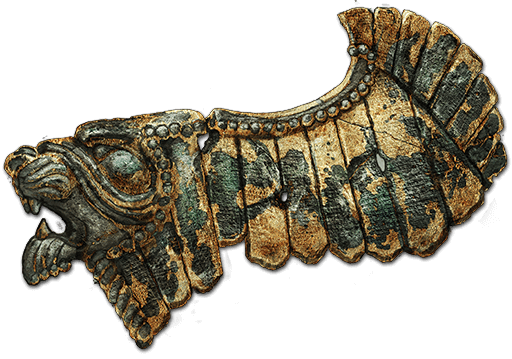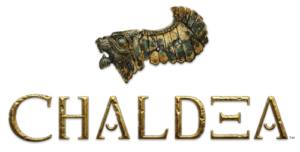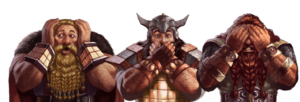D R A G O N S OF C H A L D E A
Dragons are a diverse group of creatures, serpentine and reptilian in nature, but they are actually not reptiles at all. In fact, dragons have very little in common with their unrelated lesser cousins beyond their visual similarities. Dragons are generally described as large lizards with legs, scales, and wings.
Chaldea is the birthplace of dragonkind—their legendary origins are now lost in murky antiquity, tens of thousands of years in the past. They have always been an extremely varied group of creatures. According to studies, over 300 different dragon species have been identified in fossil records. Dragons come in many shapes and sizes; some species are quadrupeds while others can easily fluctuate to walk on four or two legs. Almost all have flight capability, utilizing bat-like wings; that said, not all are flight worthy and keep certain dragons grounded. While their characteristics span an exotic array of body types, including crown modifications like horns and crests, the one commonality all dragonkind share is their enormity. “Huge” does a disservice to their awe-inspiring immensity. No fairy tale plaything, dragons are uniformly immense, towering between 20- and 30-feet at the shoulder, with wingspans surpassing hundreds of feet in some species. Legends and folklore tell tales of Ichobods, a species of iridium dragons of the Asianic, that approach the size of small mountains.
Dragons are often inaccurately described in folklore as animals or monsters, but these majestic creatures are not aberrant things spawned from over-active imaginations; instead, they are a race of sentient beings—self-aware, with acute intelligence, desire, will, ethics, personality, insight, humor, ambition, philosophy, and creativity. What set dragons apart from other sentient races of Chaldea is their antisocial contrarian behavior, fueled by a narcissistic primordial ego. Dragon philosophy on life is one of “dragon first” and everything else insignificant.
Fossils show that dragons once inhabited every continent of Chaldea and achieved planar distribution before gods took notice of Chaldea’s singular Great Sea.
Orivore
Dragon dietary requirements are unique in the realm of living creatures. They eat neither flesh nor plant life but are instead orivores—in other words, they are sustained by devouring minerals. Dragons vomit their stomach contents onto solid minerals, and the digestive juices, colloquially described as “fire,” melt the minerals into a molten metal. Once those minerals are in a liquid state, dragons drink the concoction.
Consuming minerals is what allows dragons to grow to such immense size and what makes their hides and scales “hard as stone,” an accurate and aptly phrased description. Dragon scales are as hard as the minerals they consume. An example of this metabolic process is the dragon Surienel, a species of diamond dragon, the scales of which are comprised of pure diamond crystal.
If not for their unique nutriment requirements, dragonkind might possibly be Chaldea’s apex predator, an unstoppable hypercarnivore capable of consuming all living things. Thankfully for the animal kingdom—and sentient races as well—this is not the case. Dragons are prone to leave be those who let them be. This luxury however, is not extended to the dwarves. History has shown that dragons and dwarves have the same unquenchable appetite for minerals, which has resulted in a bitter rivalry that cannot be bridged.
The Claw Hammer War
In the 10th century before Kordaava, the conflict known as the “Claw Hammer” was the first worldwide war between dragonkind and dwarves. A twenty-year bloody racial struggle between dragons (“claw”) and the dwarves (“hammer”) was ignited by greed and hunger for vital rare resources. The struggle divided dragons and dwarves on a primal level. The racial trait of dwarves is greed—it drove the dwarves to accumulate wealth, and the dragons’ desire to feed led them to eat that dwarven-accumulated wealth. Dragons quickly came to realize that it was easier to crack open the egg of wealth inside various dwarven bastions than to forage for raw ore on their own.
See Claw Hammer War
Enthusiasm for the Esoteric
Dragons are widely considered lazy, solitary creatures, seldom gathering in great numbers and avoiding humanoid civilization on the whole. This behavior has driven many to speculate that dragons are reclusive and anti-social, preferring to snooze away the centuries. While it’s true dragons do appreciate solitude, it’s not instinctual behavior they follow but rather the pursuit of other interests that keep them out of the public eye. What concerns dragons is not what concerns mortals.
“While you concern yourself with the whims of mortals,
I concern myself with Chaldea’s Grande Sonnerie.”
—Lalfroth
Their keen minds are singularly driven to master esoteric philosophies: pursuing secrets and knowledge about alternate realities, other planes of existence, and the grander mysteries of the universe. Dragons can spend eons contemplating the head of a needle and how many gold coins might be stacked there.
Dreams and Slumber
The racial trait of dragons is slumber. Dragons require significantly more sleep than other sentient races—by a large margin. Juvenile dragons require no more sleep than an average human, but as dragons age, their need for sleep increases, requiring two and sometimes three times as many hours of sleep for every hour of wakefulness, and physical exertion increases this need even further.
However, dragons can use pure force of will to “power through” fatigue, allowing the dragon to catch up on sleep requirements later. The older the dragon, the longer the calendar period can extend for this. Elder Dragons (the progenitor of the species) can push off sleep for many decades, rolling up sleep into so-called periods of hyperactivity.
Dragons are active, mystical dreamers. The nature of a dragon’s dreams varies from dragon to dragon; their proficiency at making practical use of these dreams varies as well. Dragons can enter a “light slumber,” which is less effective at rejuvenation than full rest, but it allows them to visit other entities in their dreams. Dragons are reluctant to do this, however, for the experience is very intimate. As solitary creatures, dragons are conservative when it comes to this form of communication, which requires the lowering of their emotional shields and themselves oneself up to full mental reading.
After mating, dragons fall into the deepest sleep of all. If the dragons are romantically inclined, they will curl up together and might drift into a deep sleep, interweaving their dreams together in fantasies only these wyrms can comprehend.
Celebrities
Dragons as a rule beg for solitude and peace and rarely, if ever, seek attention unless absolutely provoked. Woe to the person who provokes a dragon. But occasionally a dragon’s vast ego overpowers its common sense, and the dragon comes out of seclusion into prominence. We have to look no further than Saratof, where Lalfroth the grand vizier of the empire has a seat on the Council of Consuls. He is a solemn black wyrm routinely spotted flying over the capital, moving from his private domed citadel to the Imperial Senate.
Several dragons rule kingdoms in Chaldea, most notably Theocred, the dragon overlord of Port Facility, and Sureniel, who rules the orc nation of Niesse.
C H A L D E A P E D I A










